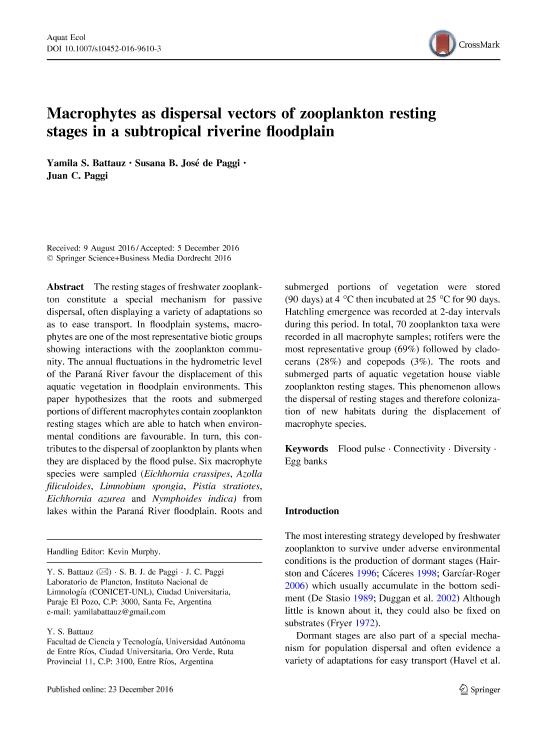Mostrar el registro sencillo del ítem
dc.contributor.author
Battauz, Yamila Soledad

dc.contributor.author
de Paggi, Susana B. José
dc.contributor.author
Paggi, Juan Cesar

dc.date.available
2018-09-16T14:34:12Z
dc.date.issued
2017-06
dc.identifier.citation
Battauz, Yamila Soledad; de Paggi, Susana B. José; Paggi, Juan Cesar; Macrophytes as dispersal vectors of zooplankton resting stages in a subtropical riverine floodplain; Springer; Aquatic Ecology; 51; 2; 6-2017; 191-201
dc.identifier.issn
1386-2588
dc.identifier.uri
http://hdl.handle.net/11336/59819
dc.description.abstract
The resting stages of freshwater zooplankton constitute a special mechanism for passive dispersal, often displaying a variety of adaptations so as to ease transport. In floodplain systems, macrophytes are one of the most representative biotic groups showing interactions with the zooplankton community. The annual fluctuations in the hydrometric level of the Paraná River favour the displacement of this aquatic vegetation in floodplain environments. This paper hypothesizes that the roots and submerged portions of different macrophytes contain zooplankton resting stages which are able to hatch when environmental conditions are favourable. In turn, this contributes to the dispersal of zooplankton by plants when they are displaced by the flood pulse. Six macrophyte species were sampled (Eichhornia crassipes, Azolla filiculoides, Limnobium spongia, Pistia stratiotes, Eichhornia azurea and Nymphoides indica) from lakes within the Paraná River floodplain. Roots and submerged portions of vegetation were stored (90 days) at 4 °C then incubated at 25 °C for 90 days. Hatchling emergence was recorded at 2-day intervals during this period. In total, 70 zooplankton taxa were recorded in all macrophyte samples; rotifers were the most representative group (69%) followed by cladocerans (28%) and copepods (3%). The roots and submerged parts of aquatic vegetation house viable zooplankton resting stages. This phenomenon allows the dispersal of resting stages and therefore colonization of new habitats during the displacement of macrophyte species.
dc.format
application/pdf
dc.language.iso
eng
dc.publisher
Springer

dc.rights
info:eu-repo/semantics/openAccess
dc.rights.uri
https://creativecommons.org/licenses/by-nc-sa/2.5/ar/
dc.subject
Connectivity
dc.subject
Diversity
dc.subject
Egg Banks
dc.subject
Flood Pulse
dc.subject.classification
Otras Ciencias Biológicas

dc.subject.classification
Ciencias Biológicas

dc.subject.classification
CIENCIAS NATURALES Y EXACTAS

dc.title
Macrophytes as dispersal vectors of zooplankton resting stages in a subtropical riverine floodplain
dc.type
info:eu-repo/semantics/article
dc.type
info:ar-repo/semantics/artículo
dc.type
info:eu-repo/semantics/publishedVersion
dc.date.updated
2018-09-14T13:21:35Z
dc.journal.volume
51
dc.journal.number
2
dc.journal.pagination
191-201
dc.journal.pais
Alemania

dc.journal.ciudad
Berlin
dc.description.fil
Fil: Battauz, Yamila Soledad. Consejo Nacional de Investigaciones Científicas y Técnicas. Centro Científico Tecnológico Conicet - Santa Fe. Instituto Nacional de Limnología. Universidad Nacional del Litoral. Instituto Nacional de Limnología; Argentina
dc.description.fil
Fil: de Paggi, Susana B. José. Consejo Nacional de Investigaciones Científicas y Técnicas. Centro Científico Tecnológico Conicet - Santa Fe. Instituto Nacional de Limnología. Universidad Nacional del Litoral. Instituto Nacional de Limnología; Argentina
dc.description.fil
Fil: Paggi, Juan Cesar. Consejo Nacional de Investigaciones Científicas y Técnicas. Centro Científico Tecnológico Conicet - Santa Fe. Instituto Nacional de Limnología. Universidad Nacional del Litoral. Instituto Nacional de Limnología; Argentina
dc.journal.title
Aquatic Ecology

dc.relation.alternativeid
info:eu-repo/semantics/altIdentifier/doi/http://dx.doi.org/10.1007/s10452-016-9610-3
Archivos asociados
